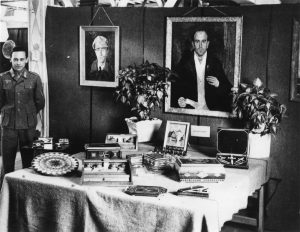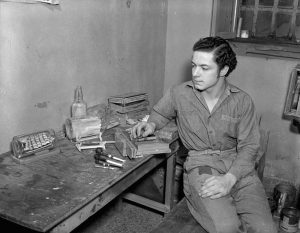The Art of Prisoners of War
First World War Veteran, Ed Peall
First World War veteran Ed Peall was as a guard during the Second World War. He worked at a few different locations, including lumber camps in remote areas in northern Ontario where German prisoners of war worked. During his service at these camps, he collected two paintings by prisoners of war (POW). These two particular works were painted on the cross sections of logs, with the bark framing the image.
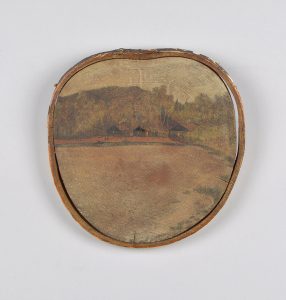
Prisoner of War Camp as painted by a German soldier. Paint on wood, 19.3 x 18.8 . 1.8 cm, Second World War.
These works give a measure of insight into the daily lives and perspectives of German prisoners of war in Canada. They contain images of isolated places without fences or guard towers, serene and calm, and beautifully painted. In one sense, these images depict a longing of freedom. Simultaneously, they also show an exploration of a new and foreign landscape. These images seem to indicate that the serene Canadian wilderness seemed a sharp contrast to Europe during wartime.
Each situation in which confined soldiers found themselves, produced a common need to both alleviate boredom and aid in their recovery. In addition, their practice allowed them to make items that met elements of their practical need. In addition, these item also became something to exchange for the necessities of life and extra comforts.
Boer War
During the Boer War, prisoners of war were interred in various locations throughout the world. Consequently, the commonly available raw materials they worked with in each location were varied. Each prisoner’s situation produced its own particular types of craft objects.
First World War
During the First World War, there were approximately 2,500 members of enemy armed forces held in Canada. Most of these were held at Fort Henry, near Kingston, ON, and they took part in all manner of activities, including the making of arts and crafts.
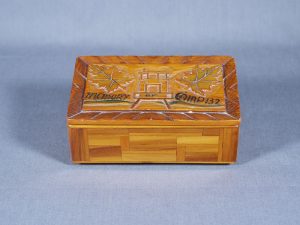
A wooden box made by a German prisoner of war. Wood and paint, 5.8 x 13.7 x 8.2 cm, Second World War.
Second World War
A much larger number of German soldiers were imprisoned in Canada during the Second World War. Between 1940 and 1947, about 34,000 enemy soldiers of all ranks and branches of the German military were housed in camps located across Canada. The Veterans Guard of Canada, made up mostly of First World War veterans, served as their primary guards.
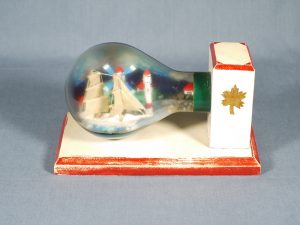
Ship in a light bulb made by a German prisoner of war. wood, glass, paint and other media, 19.7 x 9.9 x 11.3 cm, Second World War.
Monotony of Life in Prison Camps
The monotony of life in these camps was a real source of strain on prisoners, so a wide variety of diversionary activities were encouraged. Athletic competitions, theatre and musical performances, minding pets and tending gardens, reading and producing camp newspapers, attending academic classes, along with the making of arts and crafts were the primary vehicles for alleviating the tedium of life in these camps.
The YMCA
The YMCA (Young Men’s Christian Association) played a leading role in providing the equipment and materials needed to improve the quality of life for prisoners of war. “We have helped with arts and crafts work in all of the camps. Skilled craftsmen make beautiful boats, carve attractive wooden figures, paint fine pictures, and are expert in making pocket books. We have not received permission to sell this material. Canada naturally does not wish to have articles sold in competition with home products.” Eventually, this restriction on sales was lifted, and POW shows and sales took place in camps as well as department stores in Canada. One sale of German-made crafts in 1945 raised $1,185.76 to benefit the YMCA.
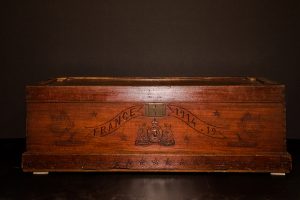
Footlocker carved by a German prisoner of war. Wood and brass, 37.5 x 120.7 x 48.3 cm, c. 1942 – 1944.
There is a wide range of German prisoner of war craft material that has survived in Canada. Much of it is made out of salvaged wood from apple boxes and other sources, and some pieces are decorated with Canadian symbols such as maple leaves. A number of items were made specifically for, or commissioned by, members of the Veterans Guard of Canada. Guards also purchased or traded with prisoners for their arts and crafts items.
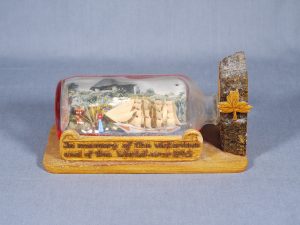
Ship in a bottle made by prisoner of war. Wood, glass, paint and mixed media, 19.7 x 9.9 x 11.3 cm, Second World War.
Perhaps the most common crafts made by German prisoners held in Canada during both world wars were tiny ships encapsulated in bottles or even light bulbs. Many prisoners of war were from the German naval forces, and this craft has a long tradition among sailors. One can see how this diminutive form of landscape/seascape symbolically encapsulated their own predicament. They were trapped in a vast country but stuck in a small space, wishing for home. The landscape depicted in most of the bottles contains windmills or high mountains on a coastline that does not seem to be somewhere specific in Canada but rather a generalized depiction of home or an escapist, dream location.
If you would like to read more about First World War veteran, Ed Peall, click here.
If you would like to see more trench art and other Canadian war-related craft, click here.


